Health Professions at University of Pittsburgh - Pittsburgh Campus
Pitt is located in Pittsburgh, Pennsylvania and has a total student population of 32,277. Of the 5,522 students who graduated with a bachelor’s degree from University of Pittsburgh - Pittsburgh Campus in 2021, 617 of them were health professions majors.
Want to know more about the career opportunities in this field? Check out the Careers in Health Professions section at the bottom of this page.
Featured schools near , edit
Pitt Health Professions Degrees Available
- Basic Certificate in Health Professions (Less Than 1 Year)
- Associate’s Degree in Health Professions
- Bachelor’s Degree in Health Professions
- Master’s Degree in Health Professions
- Doctorate Degree in Health Professions
Online Classes Are Available at Pitt
Don't have the time or the flexibility in your schedule to take traditional classes? Online courses may be the perfect solution for you. They allow independent learners to study when and where they want to while offering the rigor of in-person classes.
Pitt does offer online education options in health professions for the following degree levels for those interested in distance learning:
- Master’s Degree
Pitt Health Professions Rankings
The following rankings from College Factual show how the health professions progam at Pitt compares to programs at other colleges and universities.
Note: Although rankings can help you see some information about a school, it's not a good idea to depend on them alone. Be sure to check out other things about the school before making your decision to attend.
Bachelor’s Degree Overall Quality & Other Notable Rankings
The health professions major at Pitt is not ranked on College Factual’s Best Colleges and Universities for Health Professions. This could be for a number of reasons, such as not having enough data on the major or school to make an accurate assessment of its quality.
| Ranking Type | Rank |
|---|---|
| Most Popular Health Professions Basic Certificate Schools | 375 |
In 2021, 366 students received their master’s degree in health professions from Pitt. This makes it the #73 most popular school for health professions master’s degree candidates in the country.
There were 574 students who received their doctoral degrees in health professions, making the school the #24 most popular school in the United States for this category of students.
Health Professions Student Demographics at Pitt
Take a look at the following statistics related to the make-up of the health professions majors at University of Pittsburgh - Pittsburgh Campus.
Pitt Health Professions Associate’s Program
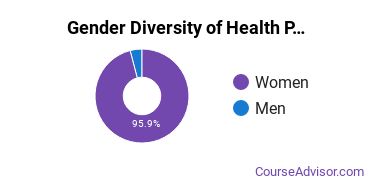
The majority of those who receive an associate's degree in health professions at Pitt are white. Around 80% fell into this category, which is below average for this degree.
The following table and chart show the race/ethnicity for students who recently graduated from University of Pittsburgh - Pittsburgh Campus with a associate's in health professions.
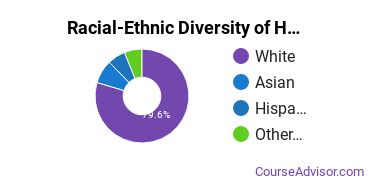
| Race/Ethnicity | Number of Students |
|---|---|
| Asian | 4 |
| Black or African American | 0 |
| Hispanic or Latino | 3 |
| White | 39 |
| International Students | 0 |
| Other Races/Ethnicities | 3 |
Pitt Health Professions Bachelor’s Program
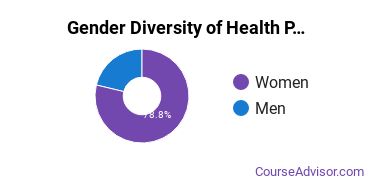
About 79% of those who receive a bachelor's degree in health professions at Pitt are white. This is above average for this degree on the nationwide level.
The following table and chart show the race/ethnicity for students who recently graduated from University of Pittsburgh - Pittsburgh Campus with a bachelor's in health professions.
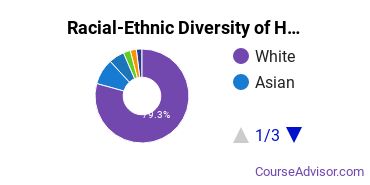
| Race/Ethnicity | Number of Students |
|---|---|
| Asian | 55 |
| Black or African American | 12 |
| Hispanic or Latino | 15 |
| White | 489 |
| International Students | 13 |
| Other Races/Ethnicities | 33 |
Pitt Health Professions Master’s Program
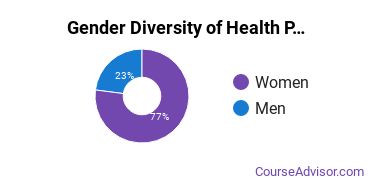
Of the students who received a health professions master's degree from Pitt, 70% were white. This is above average for this degree on the natiowide level.
The following table and chart show the race/ethnicity for students who recently graduated from University of Pittsburgh - Pittsburgh Campus with a master's in health professions.
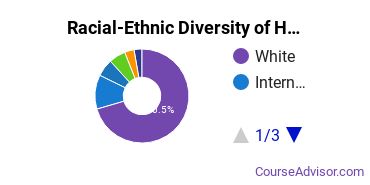
| Race/Ethnicity | Number of Students |
|---|---|
| Asian | 22 |
| Black or African American | 10 |
| Hispanic or Latino | 12 |
| White | 258 |
| International Students | 43 |
| Other Races/Ethnicities | 21 |
Pitt also has a doctoral program available in health professions. In 2021, 574 students graduated with a doctor's degree in this field.
Concentrations Within Health Professions
The following health professions concentations are available at University of Pittsburgh - Pittsburgh Campus. The completion numbers here include all graduates who receive any type of degree in this field from University of Pittsburgh - Pittsburgh Campus. Some of these focus areas may not be available for your degree level.
| Concentration | Annual Degrees Awarded |
|---|---|
| Rehabilitation & Therapeutic Professions | 403 |
| Nursing | 359 |
| Pharmacy/Pharmaceutical Sciences | 220 |
| Medicine | 139 |
| Communication Sciences | 119 |
| Dentistry | 86 |
| Health & Medical Administrative Services | 72 |
| Public Health | 66 |
| Dental Support Services | 64 |
| Medical Science | 49 |
| Allied Health Professions | 47 |
| Advanced Dentistry & Oral Sciences | 35 |
| Other Health Professions | 30 |
| Mental & Social Health Services | 16 |
| Dietetics & Clinical Nutrition Services | 14 |
| Bioethics/Medical Ethics | 2 |
Careers That Health Professions Grads May Go Into
A degree in health professions can lead to the following careers. Since job numbers and average salaries can vary by geographic location, we have only included the numbers for PA, the home state for University of Pittsburgh - Pittsburgh Campus.
| Occupation | Jobs in PA | Average Salary in PA |
|---|---|---|
| Registered Nurses | 148,520 | $70,390 |
| Personal Care Aides | 121,300 | $24,880 |
| Nursing Assistants | 76,260 | $30,630 |
| Office and Administrative Support Worker Supervisors | 68,240 | $60,800 |
| Licensed Practical and Licensed Vocational Nurses | 38,370 | $48,120 |
References
*The racial-ethnic minorities count is calculated by taking the total number of students and subtracting white students, international students, and students whose race/ethnicity was unknown. This number is then divided by the total number of students at the school to obtain the racial-ethnic minorities percentage.
- College Factual
- National Center for Education Statistics
- O*NET Online
- Image Credit: By Crazypaco under License
More about our data sources and methodologies.
Featured Schools
 Request Info
Request Info
|
Southern New Hampshire University You have goals. Southern New Hampshire University can help you get there. Whether you need a bachelor's degree to get into a career or want a master's degree to move up in your current career, SNHU has an online program for you. Find your degree from over 200 online programs. Learn More > |
